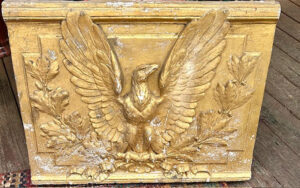A Different Eagle Full of Symbolism
 KC sent me a “relief” three-dimensional image of an eagle. This work created out of plaster, a plaque, boxed in the image on three sides measures seventeen by twenty-eight inches. KC found it in the basement of an antique dealer years ago.
KC sent me a “relief” three-dimensional image of an eagle. This work created out of plaster, a plaque, boxed in the image on three sides measures seventeen by twenty-eight inches. KC found it in the basement of an antique dealer years ago.
Instead of the typical spread-wing eagle associated with American iconography, KC’s eagle shows wings pointing straight up, similar to those in Roman Classical design. Instead of the typical American symbols of the olive branch in the dexter, right talon, and arrows in the sinister, left talon, this eagle holds the olive branch in the sinister and an oak branch in the dexter talon. American bald eagles on coins, the Great Seal designed in 1782, architecture, and Federal furniture feature a stars and stripes shield over the eagle’s breast.
KC’s eagle IS DIFFERENTWhat’s the eagle’s origin? The key to KC’s eagle is the symbol of the eagle itself, representing kings, power, and the status quo. This goes back to Greek mythology in the eagle of Zeus, and later in Roman times, the symbol of Jupiter, the King of the Gods, as his eagle, his messenger, or incarnation. Charles Thomson, American Secretary of the Continental Congress in 1782 modified this Classical eagle iconography to feature the bald eagle, a true American native species, for the Great Seal.
We find animal images used as symbols of strength in many mythologies. I mentioned the eagles of Zeus and Jupiter. There‘s also Ibis of Thoth in Egyptian culture. In Hinduism there’s the eagle-man Garuda, and Ganesha, the god with the elephant head.
Animals Symbolize Certain AttributesFor millennia the eagle represented kingship, dominion, strength, power, wealth and majesty. In the 17th and 18th century the eagle meant the power of money, thus the symbol’s incorporation in money, symbolizing financial power. Also used in a family crest (heraldry). Eagle images were used in Europe and America on architecture that represented national wealth, family wealth, and banking.
KC’s eagle, with its oak and olive branches, most resembles eagles associated with banking and financial institutions. The symbol of the oak tree represents solidity. The olive branch symbolizes peace. When associated with money, the images mean wealth and stability.
The American dime of the late 19th century features both the olive and the oak branch. Although these two symbols aren’t paired with an eagle, but with a torch on our ten cent coin. The olive branch is seen on the left of the torch.
I found a similar eagle, with an olive and oak branch, and upright wings in the Roman style, on French and American architecture and objects associated with banking of the 19th century. French banks of the period bore emblems of both the oak and the olive branch, with or without an eagle symbol.
The French Eagle ConnectionThe connection between the eagle of French monetary symbolism, and the American monetary symbolism are close cousins. Congress debated the establishment of the US National Bank as an institution for our young country 1789-1801. History calls this the Federal Period because French and American finances became closely associated, for good and bad, profit and debt. The US borrowed greatly from France, and France demanded that debt repaid. Debate over banking and national debt waged between American French supporters and isolationists. In 1795 the US settled its French debt and begun in earnest our own National Bank.
KC’s eagle was designed in relief on plaster which means this plaque was part of a wall or building, thus, incorporated into architecture. Perhaps once an emblem of a bank. I surmise they didn’t create it for an American bank. Plaster was used for exterior decorative elements throughout the 19th century, and I assume this created in the mid to late 19th century with a European origin.
KC, I can’t give you a value on this plaque, but I postulate $500-ish. We’ve uncovered these details: it’s most likely French and associated with banking, It served as part of a structure as a decorative object, and it symbolized solidity, power, and stability.
The post A Different Eagle Full of Symbolism appeared first on Elizabeth Appraisals.
Elizabeth Stewart's Blog
- Elizabeth Stewart's profile
- 5 followers



